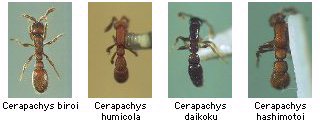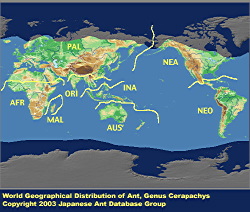
|
genus
|
Cerapachys
|
 |

|
|
Japanese Name
|
Kubire-hari-ari-zoku
|
Original Reference
|
|
Smith, F. (1857) Catalogue of the hymenopterous insects collected at Sarawak, Borneo; Mount Ophir, Malacca; and at Singapore, by A.R. Wallace. Journal of the Proceedings of the Linnean Society of London, Zoology 2: 42-88.
|
Description
|
|
Antennae 9- to 12-segmented; scape clavate; terminal segment often bulbous. Antennal insertions exposed, separated by a median vertical, longitudinal lamella. Areas surrounding antennal insertions flat or concave; enclosed laterally by a ridge or carina. Anterolateral portions of clypeus forming small projections just above the mandibular insertions. Eyes often absent, varying from large to minute in size when present. Trunk subrectangular, with parallel sides and flat dorsum; promesonotal suture and metanotal groove absent. Middle legs with a single tibial spur. Petiole sessile. The first segment behind the petiole (III true abdominal segment) often separated from remainder of the gaster by a constriction, and sometimes referred to as the postpetiole.
|
|

|
Remarks
|
|
Many species of Cerapachys nest in soil or under stones. The workers vibrate their antennae vigorously when walking. The raiding of nests of other ants (such as Pheidole) has been observed in many species (Brown, 1975; Hoelldobler, 1982; etc.). Cerapachys includes about 140 species world-wide. Most are found in the tropical African and Indo-Australian regions. In Japan the genus is represented by 4 species, two of which were recently described by Terayama (1996).
|
References
|
|
- Brown, W. L., Jr. (1975). Contribution toward a reclassification of the Formicidae V. Ponerinae, tribes Platythreini, Cerapachyini, Cylindromyrmecini, Acanthosticihi and Aenictogitini. Search, 15, 1-115.
- Hoelldobler, B. (1982). Communication, raiding behavior and prey storage in Cerapachys (Hymenoptera: Formicidae). . Psyche, 89, 3-23.
- Terayama, M. (1996). Taxonomic studies of the Japanese Formicidae, part 2. Seven genera of Ponerinae, Cerapachyinae and Myrmicinae. Nature and Human Activities, 1, 9-32.
|
Editor
|
|
Original text Kazuo Ogata and Mamoru Terayama. English translation by Kazuo Ogata, edited by Robert W. Taylor
|
|